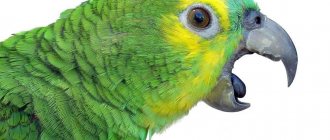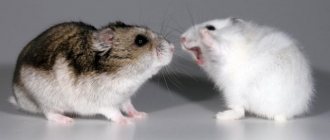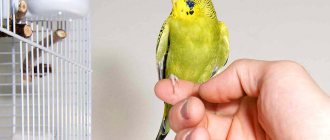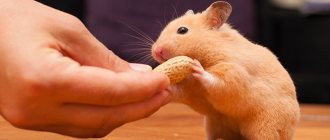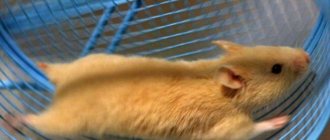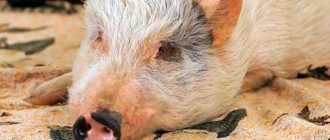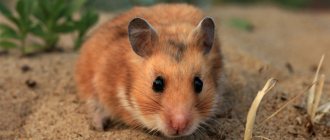- home
- Reproduction
15.04.2018
It is not uncommon for individuals of the same species to eat each other and their offspring. Cannibalism is inherent in insects, birds, primates, and predators. This phenomenon occurs quite often among rodents. The reason why hamsters eat their babies must be sought in the instincts of the animal.
First of all, it should be remembered that in their natural environment hamsters are loners. There is no need to introduce a friend or girlfriend to your pet so that the animal does not get bored alone. But if hamsters are brought together at an early age, they can exist quite peacefully in the same area, if the size of the cage allows. If the pets are of different sexes, be prepared for the imminent appearance of offspring.
An adult hamster ate another adult hamster
You should know that hamsters don’t just eat each other. This is abnormal rodent behavior. If this happens, you need to figure out what’s going on and prevent reoccurrences.
Causes:
- They divide the territory . Hamsters are territorial animals. In the wild, their entire territory is divided. Unless absolutely necessary, they try not to leave their possessions, and also do not allow strangers to visit them. If in nature there is enough space for them to separate and live separately, then at home there is no such opportunity. Owners make a mistake when two different-sex individuals inhabit the same cage. Hamsters are solitary by way of life. They don't get bored, they don't need a friend, and even without the owner's attention they feel good. Same-sex individuals should live in different cages, or they can be placed in one large cage, but be sure to install a partition. Even if one hamster does not eat the other, they can injure each other. Since hamsters are nocturnal animals, owners do not even suspect what happens at night. Due to daily fights, hamsters are constantly nervous and stressed, which significantly shortens the lifespan of rodents.
- Lack of food. Also, a hamster can eat another one if there is no food. If the owner forgot to leave food in the cage, then the feeling of hunger will force the hamsters to resort to cannibalism. The strongest will survive, the stronger individual will eat the weaker one.
- The female protects the offspring . Another situation in which a hamster can eat another is when the female is protecting her offspring. After mating, the male must be placed in another cage. Males lack nurturing instincts; they do not care or care for their offspring. If you leave a male in a cage and offspring appear, he will attempt to kill the cubs. For him, they are rivals with whom he does not want to share territory. To protect and save her cubs, the female can kill the male.
- Fight for the female . To breed hamsters you need 2 individuals of different sexes, where the third will be superfluous. If there is one female, and there is more than one male, then during the mating season there will be fights for the female’s attention. During this period, hamsters are quite aggressive and can bite an opponent to death.
Why do hamsters eat each other?
Never keep two hamsters in the same cage. This will not lead to anything good. Constant stress and fights can be fatal.
Cannibalism doesn't just happen to newborns. One adult animal is capable of eating another. You need to know this feature. Especially if you want to buy a second pet and put it in the cage with the first one so that both of them don’t get bored. This will be a critical mistake. They will both be under constant stress. This will affect their health and life expectancy. Wildlife spares no one. There, everyone has their own territory into which they do not allow others, this especially applies to hamsters. Their territory is strictly divided. Therefore, when they are in the same cage for a long time, fights can happen constantly. Since they are nocturnal animals, you may not notice it. But one morning only one animal may be alive. Survival of the fittest, just like in the wild. The weak man had no place to retreat and therefore he died. Hamsters eat each other very rarely, but the fight can end in injury or death of one.
The mother is not able to feed so many children
Most often this happens during the first birth, when the hamster is not confident in itself. Not only did pregnancy take a lot of energy and nutrients, then childbirth took the last of my strength, and then there are so many mouths to feed. The hamster may conclude that she cannot cope with everyone, this will cause the hamster to eat some of her babies. He will leave as many as he can feed.
Proper nutrition, which contains all the necessary nutrients, will help avoid this outcome. That is, there must be both special food and vegetables, fruits, vitamins and water.
Hamster is not ready
This is a very likely reason that a hamster eats its babies during the first birth. He simply does not feel ready, the maternal instinct is not developed. Subsequent pregnancies will not bring such problems. In this case, you can try feeding the children yourself. But be prepared that this will take a huge amount of your time. You need to feed them milk through an injection without a needle or a pipette every 2-4 hours. That is, you will get rid of normal sleep for 3 weeks until they can feed on their own.
Coprophagia: norm or pathology
Coprophagy in a healthy and beneficial manifestation is observed in animals. For people it is unnatural and an indicator of mental deviation. But in the animal world, coprophagy is part of the animal's food cycle. When consuming different foods, the stomach of guinea pigs does not always absorb all the nutrients. And so partially processed food is eaten for processing a second time. For the health of domestic rodents, this form is an integral and beneficial part of the food chain. Eating feces normalizes intestinal function, receives missing vitamins, and processes lumps in the stomach.
Male not placed in another cage
After mating occurs, the male must be immediately transplanted into another cage. The male has no parental instinct and there is almost no doubt that after giving birth he will eat his cubs.
Many people mistakenly believe that this is due to jealousy, saying that he lacks the female’s attention. But let's not attribute human passions to this, albeit very smart animal! As mentioned above, hamsters are solitary by nature and the usual struggle for territory comes into play. There are too many competitors that are easier to destroy while they are small.
Human intervention
A good breeder knows that hamsters do not allow strangers into their territory. Even simple cleaning of the cage, carried out without stress for the animal, is already a great art. A pregnant and lactating female is especially strict about protecting her area. A few days before the expected birth, you need to thoroughly clean the cage and transplant the expectant mother into a container. Add more bedding and add white paper napkins to equip the nest. If necessary, move the cage to a more convenient place. After the birth of the animals, you cannot touch it for at least a week.
After the birth of the babies, any physical contact between a person and a pet is prohibited for 1-2 weeks. The feed is added carefully, preferably using tongs. This is done in order to prevent the smell of a foreign animal from entering the cage (and a person is a foreign animal to a hamster). Seeing a threat, the female can rush to protect the offspring and bite the owner.
Do not allow children to approach the cage, look at the cubs, or pick up the mother or the hamsters. Sensing a foreign smell, the hamster eats her children, considering them strangers or sick.
When babies begin to eat food, the danger of being eaten becomes less. Even if the mother smells a foreign odor from the baby, she may refuse to feed him milk, but he is no longer in danger of starvation.
Excessive attention from owners
Close attention and excessive care will harm not only human relationships, but can also cause cannibalism in female hamsters. Since this rodent is a solitary animal, and after the birth of the cubs, the female needs a secluded environment and tranquility even more, excessive care will only harm these animals. Do not pick up hamsters and do not get into the cage. Let your family see you less.
Foreign odors repel the mother hamster. Sensing a foreign smell, she does not identify the cubs as her own creatures and, as a result, abandons them and destroys them. Do not touch the hamster family for one to two weeks after the babies are born!
It is necessary to prepare in advance for the new offspring of furry rodents. When cleaning the cage, if you find hamster supplies, do not touch them. This is a strategic supply of products, which unpleasantly traumatizes the animal’s psyche in the event of its loss, even to the point of an uneven breakdown in a pregnant female. Only spoiled products can be thrown away to avoid the growth of putrefactive bacteria, odor and poisoning.
To arrange your own nest, it is recommended to put a few paper napkins. Your task is to fill the drinking bowl with clean drinking water and pour food into the feeder on time. This is all that the rodent needs from its owner at this time. Nature will do the rest.
The cubs are destroyed by the male
This problem often arises when domestic rodents eat each other or their offspring. Many believe that the main reason for such terrible behavior of hamsters is their cage together. But is this really so?
The male, who is in the same cage with the hamster, feels rejected after the birth of the offspring. Small rodents are real competition for him. That's why he eats them. After the birth of the cubs, the mother becomes especially aggressive and does not allow the male to approach her. The lack of opportunity to mate prompts the male to take such actions.
Another important point is that if hamsters of different sexes are constantly in the same cage, then the hamster will bear offspring every two weeks. She becomes weak, like each subsequent offspring that is born. Weak hamsters are simply doomed to death. Sooner or later they will be eaten, if not by the female hamster, then by the male.
Other causes of cannibalism
Sometimes it happens that young mother hamsters eat the first litter.
This does not happen because they are considered bad mothers. It’s just that the young individual does not fully understand what happened to her, and eats the hamchat as a nuisance. With the next offspring she will be loyal. Some believe that the female eats babies that do not match her color. For example, if the mother is black, and the hamsters were born black and white or white, then she will certainly eat them. It's all a myth! The color of the cubs has nothing to do with it. A Khomchikha can regulate the number of her offspring, taking into account her maternal capabilities.
https://youtube.com/watch?v=JxoEBZDdifQ
Possible reasons for eating baby hamsters
Offspring with health problems
In the wild, in order for the entire viable hamster species to survive, weak offspring are destroyed, which will interfere with the rodents' ability to escape from danger.
Domestic hamsters, which have long been tamed by people, remain true to their natural instincts, developed over centuries, which have saved them for a long time in the wild.
Born sick and weak, hamsters are usually eaten by their mothers. Injuries received by hamsters before or after birth equally make newborn babies weak and are immediately classified as non-viable. Such cubs, with almost one hundred percent probability, will be destroyed.
Important! If you notice a sick or even dead hamster in the cage, do not remove it; the female herself decides what to do with it. Your unnecessary interference may cause the death of all remaining offspring
This is due to foreign odors. Not being able to smell herself, the mother may start to panic and kill the rest of the newborn hamsters. Don't worry, these rodents eat everything, including meat. No matter how shocking it may sound, the female herself will “clean up” her nest.
If this does not happen within several days, then use gloves to remove the dead cub. This will at least somehow protect other hamsters from your smell.
Unpreparedness to become a mother
Often, the first pregnancy of a female hamster can cause severe anxiety, anxiety and drive the young mother into a stressful situation.
The female is not ready for pregnancy, nor for giving birth and caring for her babies. This reason can provoke the killing of unwanted offspring. The subsequent gestation of offspring and their birth usually do not cause such a reaction in the female.
Weight of cubs
Many or seemingly large numbers of newborn babies. Having become a mother for the first time, doubts overcome both people and animals. Can I cope, do I have enough milk? Your female, who was very small herself, gave birth. I lost a lot of energy and vitality. And then numerous newborn offspring squeal nearby and ask for food. The hamster may panic and think that she won’t be able to feed everyone, and it will be difficult to cope with such a horde of babies. Therefore, this is where natural instinct kicks in; several individuals of the offspring can be eaten.
In order not to provoke the occurrence of such a situation, the owner needs to improve living conditions and improve the hamster’s nutrition as much as possible. She now needs nutrients and minerals, as well as vitamins. Feed her special food for pregnant females, vegetables and fruits. Don't forget about clean water.
Male living with offspring
After the process of mating a female with a male, they must immediately be separated into different cells. This is due to the fact that the male is completely devoid of any parental instincts. He will not even think about whether to leave his offspring or not, he will destroy them.
Some owners think that the hamster is jealous of the offspring of the female and receives little attention from her. In fact, such passions do not need to be attributed to them. Let us remember that the hamster is a loner by nature. And the struggle for territory is ongoing all the time. Here in the cage there is a whole brood of competitors, which are easier to deal with while they have not yet grown.
Common causes of falling on your back
However, not everything is so scary. When a hamster falls on its back, it may just be playing. The main reasons that can cause an animal to fall are:
And yet, if the hamster falls on its back, tumbles, runs on the drum, behaves actively, eats well, there is no need to worry, since everything is fine with it. In order to understand what provoked such animal behavior - a desire to have fun or illness, it is enough to observe for some time.
Due to excitement, it is difficult to figure out what to do if the hamster lies and does not move, but is breathing. After all, the presence of breathing means that the animal is still alive.
Before you run to the vet, you need to try to figure out why your pet is lying motionless
Pay attention to other signs: whether the eyes are closed, how often the rodent breathes. If the eyelids are closed and breathing is calm, the hamster may just
If a previously healthy animal suddenly falls into a coma, it is possible that it is hibernating. Breathing will be very rare, and the pet will be cold to the touch. In nature, dwarfs hibernate in winter, waiting out cold, hunger and short daylight hours.
Low room temperature
If the heating was turned off in the apartment, or you were going on vacation, this could provoke numbness. The body will be cold, the heartbeat will be extremely rare (1 beat every 15 seconds). A sleeping hamster can barely breathe; due to its small size, it is difficult to understand whether there is breathing at all. But if the body remains soft, the rodent has not died. To awaken the animal, the cage is placed in a warm room (more than 20 C), the feeder and drinking bowl are filled. The hamster should wake up in 2-3 days.
Heat
The Djungarian hamster lives in the steppes, and the Syrian even in semi-deserts, but both species are extremely sensitive to high temperatures and direct sunlight. Tiny nocturnal rodents with dense fur have no protection from overheating - they do not sweat or breathe through their mouths like dogs. Heat stroke is deadly for them.
Signs of hyperthermia:
- the hamster does not move and is breathing heavily;
- weakness;
- convulsions;
- impaired coordination of movements.
In case of acute overheating, heart failure leads to the death of the pet. Death may not occur immediately, but within a couple of days due to the failure of all organs, if the temperature has risen so much that proteins have coagulated in the blood and organs (at 44 C).
Situations in which there is a risk of heat stroke
- a cage on a windowsill or balcony, outside (sun);
- near heating devices;
- in a stuffy room with high humidity.
It can be difficult to understand why a hamster is lying on its side and breathing heavily if by the time the owner returns the sun has already gone and does not illuminate the cage.
Treatment for heat or sunstroke
Transporting a pet to a clinic in case of heat or sunstroke is not the best solution; time for first aid will be missed. What can you do without the help of a veterinarian to help your pet:
Reduce temperature
First aid is to cool the body, but not too sharply: applying ice or immersing the hamster in water is prohibited! The animal is placed on a tile or ceramic dish, or on a damp towel
Gently moisten ears and paws with cool water.
Fighting dehydration
Heatstroke very often occurs when there is no access to. When the animal is unconscious, it can no longer use the drinking bowl. However, it is also dangerous to drink a hamster from a syringe: it will not swallow, and the liquid will enter the lungs, making breathing difficult and causing pneumonia.
The liquid (sterile Ringer's solution or sodium chloride) is injected subcutaneously into 4-8 ml of Syrian and 2 ml of Djungarian hamsters.
Antishock therapy
Although all potent medications are best used as prescribed by a doctor, in a situation with acute overheating, the hamster may not survive to take the ratologist. If you feel like you have nothing to lose, you should inject prednisolone 30 mg/ml intramuscularly (in the hind leg) with an insulin syringe. The dose for a Dzhungarik is 0.05 ml, for a Syrian - 0.1 ml.
Whether your pet survives may depend on how long it was exposed to the high temperature. If the hamster does not die immediately, on the first day after overheating the owner often notices that the hamster falls over on its side and can barely walk. Neurological disorders are associated with swelling of the brain, and if the pet survives, coordination of movements will gradually be restored.
The female or male eats the offspring
Hamsters are not only easy to keep at home, but they also breed easily in captivity. To avoid cases where a female or male eats their offspring, it is important to study breeding information, prepare and change the diet, housing conditions and care.
If not properly cared for, the female will be forced to eat her children in order to save them from unfavorable conditions. Yes, that's exactly how she eats them, to protect them. Let's figure out in what cases this happens.
Reasons why the female eats the offspring:
- First pregnancy . Puberty in hamsters occurs at the age of 2 months. But it is better to allow individuals who are 4 months old to be bred. Early pregnancy can have a negative impact on the offspring. The female is simply not ready to become a mother. She does not understand what is happening and is in a stressful state. Because of this, the female can eat all the offspring. This can happen during the first pregnancy, even if the female has reached the age of 4 months or more. However, subsequent pregnancies usually go well and previous experience does not affect the offspring in any way.
- Alien smell . During pregnancy, the female should approach the cage only as a last resort, to fill the feeder or drinking bowl. During this period, it is not recommended to even clean the cage. When the cubs appear, you should never touch them with your hands. A foreign smell can repel the female from her offspring; she will consider them alien and destroy them. Small hamsters can be handled no earlier than 2 weeks after birth.
- Lack of food and supplies . In normal times, hamsters' supplies are often taken away because the food spoils and becomes hazardous to the hamsters' health. It is not recommended to clean the pantry during pregnancy and after childbirth. If some products have spoiled, they should be removed and replaced with others. In the absence of food, the female, saving her offspring from starvation, can also destroy them.
- Extraneous noise . Small hamsters are very shy. The cage should not be placed near a music center or near a TV. If the female is frightened, she may eat her offspring to protect them from danger.
- Other animals . Rodents are rarely friends with other pets. They often feel threatened and are stressed. And when the female is frightened, she destroys the cubs.
- Sick cubs . It happens that some cubs are born sick or already dead. There is no point in removing a dead hamster; let the female decide what to do with it. If she doesn’t touch him for a couple of days, then you need to put on a glove and carefully remove him from the cage. If the female decides that some of the babies are sick, she will destroy them so that stronger and healthier individuals survive.
- Large offspring . If many babies are born, the female needs to increase her daily food intake and also add vitamins to her diet. If the female feels that she is not able to go out and feed such a number of cubs, then natural instinct will kick in and some of them will be eaten.
- Male in a cage . After mating, the male must be placed in another cage. Otherwise, the female will be forced to protect the offspring. And if the male is stronger, she will eat the cubs to protect them.
- The male can also if he is not placed in another cage. He has no paternal feelings; for him, cubs are rivals with whom he needs to share territory. The female may not be able to cope with the male, and he will eat all the offspring.
To avoid cases of cannibalism, you should adhere to the rules for keeping hamsters. Same-sex individuals cannot be housed in the same cage; after mating, the male must be separated from the female. It is also necessary to create favorable conditions for pregnant hamsters and select a special diet, which, in addition to the grain mixture, should include vegetables and fruits, as well as vitamins and mineral mixtures.
Features of reproduction
Among the people, hamsters are known as very prolific animals, although this is only partly true. In captivity, hamsters actually breed all year round, but in the wild they obey instincts and reproduce only in the spring and summer. On average, a female gives birth 2–4 times per year, and the number of cubs in a litter varies greatly - from 1 to 18, but on average 8 animals are born in a litter.
The ability to reproduce offspring occurs already at the age of 1.5–2 months, although at such an early period pregnancy may not end successfully. It is optimal to mate a female from 4 months and a male from 3 months. In this case, the male can be used as a sire until the age of 10 months.
Did you know? Did you know? The most numerous offspring of a hamster is a litter of 26 cubs, which was produced by a hamster from the American Miller family in 1974.
When does the male eat the cubs?
It is worth noting that more often it is the female who eats the offspring, but sometimes the father of the furry family can also dine on the children. The only reason a male can do this is a feeling of jealousy towards the female.
They have almost no paternal instinct, and males perceive offspring as competitors, since while the female feeds the babies with milk, she is not able to mate.
In addition, female hamsters are angry and aggressive during pregnancy and after it; they can bite or chase the daddy hamster around the cage for no particular reason. And he sees the origins of all troubles precisely in the offspring and at the first opportunity gets rid of them.
That is why it is recommended to place the male in a separate cage immediately after birth.
Rivalry
Sometimes hamsters eat their teenage babies. This behavior is associated with the division of territory. The grown offspring become competitors and begin to be exterminated. Indeed, in nature, babies leave their mother at the age of 3-4 weeks.
Such a struggle may not be visible to a person. Hamsters that peacefully coexist during the day carry out massacres at night. Then they have an active time, in the morning the owner discovers the remains. Adult hamsters do not understand that they are eating their children; they simply eliminate competitors in the living space.
For the same reason, daddy hamsters eat children. Males completely lack the instinct to raise offspring. For him, newborns are strangers from the very beginning. Therefore, it is important to separate the male from the female immediately after mating. If this is not done, there are two options:
- the female will bite the hamster because she feels a threat to herself and her offspring;
- the male will eat the cubs, considering them a nuisance.
Both a wild hamster and domestic dwarfs will do the same, since their instincts are the same.
What happens in a normal nest
Being in position, the female hamster prepares a shelter for her offspring. After 3 weeks, up to 20 baby hamsters are born. To build a nest, you need soft material: napkins, paper towels, shredded paper, hay are suitable.
A thrifty housewife will create food supplies inside and outside the building. During pregnancy and feeding, the mother hamster's appetite increases, but the diet as a whole does not change. The main food products remain seeds, fruits, vegetables and pellets. Occasional treats are appropriate and fresh water should always be available.
Rabbit at home
Normal hamster nesting behavior
In anticipation of offspring, female hamsters begin to prepare a nest.
Hamster pregnancy only lasts about three weeks, and up to 20 babies can be born in a hamster's nest overnight, even if you didn't know your hamster was pregnant.
Hamsters will use a variety of soft materials to create a comfortable nest for their offspring. Wipes, paper towels, shredded paper, and cage bedding are often used. Food is also sometimes stored in or around the nest.
Hamster cannibalism: why do hamsters eat their puppies and each other? Great attention, excessive guardianship will harm not only human relationships, but can also become a reason for
What do newborn hamsters look like?
Why do dogs eat grass? Newborn hamsters are completely hairless, so they look like a red, swarming mass. Their ears and eyes are closed; only their sense of smell allows them to navigate. Babies may squeak loudly if they are cold or hungry. If the mother takes good care of the offspring, the babies do not make a sound. Sometimes the owner discovers that there are newborn hamsters in the house, by accident - when cleaning the cage, or when grown-up children of hamsters begin to crawl out of the nest.
Newborn hamsters
A baby hamster is no larger than the phalanx of a finger, weighing 1-2.5 g. In the first days, it can be difficult to count the offspring, especially since the female feeds the children, lying on them with her whole body. It is not recommended to look into the house so as not to disturb the hamster.
Although dwarf hamsters are much smaller in size, newborn Syrian hamsters are not very different in size from dwarf hamsters. The fact is that Syrians are multiple: the more children in one litter, the smaller the size of each hamster.
Newborn Hamster Size
Causes of abnormal eating behavior
Lack of food usually leads to disastrous consequences. But it’s strange to watch how your own child is devoured if the mother is full.
1. Stress - any human mother is familiar with this phenomenon. It is hard to bear the burden of giving birth, feeding and caring for several children. If the animal is under excessive stress, it will eat the burden. Apparently, caring becomes an unbearable test and leads to the only way out - to get rid of it. Characteristic of young hamsters eating their young.
2. Fear - for many parents it is natural to want to protect their babies, hamsters are no exception. Fear motivates one to kill and eat. The owner is perceived as a threat. Loud noises and other pets frighten and encourage babies to eat.
3. Smell - the hamster spends a lot of time caring for the babies. If a new smell is detected on the skin, for example, a human one, it gets confused and mistakes them for impostors.
4. Lack of food is the most obvious reason. An animal carrying a burden or feeding milk spends a lot of energy. Therefore, more food is needed.
5. With a large litter, the mother decides that she does not have enough strength, and eats part of the cubs. This is done for the benefit of the remaining offspring as part of survival, even if it seems inhumane.
Too early pregnancy and childbirth
A female hamster reaches childbearing age at 4 months of age. This is a physical opportunity to bear and feed offspring, but psychological maturation comes a little later. A mother who is too young may be frightened of her cubs and “eliminate” them simply because she does not know what to do with them next (you can compare this with pregnancy at 13-14 years old in a person; such a young girl rarely becomes a good mother). In subsequent pregnancies, such a female becomes an exemplary mother; past experience does not in any way affect the new cubs.
Preventing hamsters from eating their babies
Place the mother hamster in a quiet and peaceful place, away from children and other pets. Try not to make noise; you can cover the cage with a blanket.
Look at the babies, but do not touch them, especially in the first week of life. Provide qualitatively and quantitatively sufficient food.
Whether to get a hamster is up to you.
Star rating
[Total: Average: ]
Large or seemingly large numbers of young
The first birth is always difficult and not only for people. Having experienced such stress, a hamster may lose confidence in its abilities. Well, imagine - such a baby suffered a pregnancy, which took a lot of strength and nutrients, followed by a painful birth, and numerous offspring that need to be fed somehow! The hamster may panic and decide that she cannot cope with so many offspring and will eat several individuals. To avoid such a sad situation, it is necessary that the animal’s nutrition is as complete as possible; there is no deficiency in vitamins and nutrients. This should include special food, fresh fruits and vegetables, and clean water.
How to avoid loss of offspring
You can minimize the risk of hamsters eating their babies by following these rules:
- keep pets of different sexes in the same cage only during the mating period;
- prevent stress in hamsters;
- do not allow feeding of meat and meat products, including bone, blood and meat-and-bone meal;
- do not touch babies during breastfeeding;
- provide a complete diet for the female after childbirth;
- do not allow fertilization of females until 6 months of age;
- Separate babies from their mother at the age of 3–4 weeks.
Why does a hamster eat her babies?
Nature has endowed the maternal instinct not only with people, but also with animals. But it also happens that for some reason the female does not want to take care of the offspring. Among the reasons why a female hamster can dine on her babies are:
- Mothers who are too young, as a rule, do not yet have a strong maternal instinct; this applies to hamsters under four months of age.
- The main reason is the lack of milk in the female; the mother is forced to kill half of the offspring in order to feed the rest. Make sure that the new mother has 24-hour access to water and wet food, her diet greatly affects milk production.
- The so-called natural selection also plays a role; mother hamsters can eat a baby hamster that is too weak.
- Females after giving birth are very aggressive, they can eat the cubs under the slightest stress, be it bright light or strong noise.
- You should not pick up newborn hamsters or disturb their house; the mother may not recognize the children by smell if you touch them.
- Most often, children are eaten by females weakened from frequent childbirth, as well as those who gave birth through family ties.
Rodents can reproduce indefinitely
If one hamster is not enough for you, then by purchasing a second rodent of the opposite sex, you can get a dozen individuals in just a couple of months. After four weeks from birth, hamsters can mate. Pregnancy lasts from 18 to 22 days. The Syrian uterus can bear 24 hamsters at a time. Although, most likely, after pregnancy you should expect a replenishment of 3 to 12 rodents.
10 Hanna-Barbera cartoons that tried to repeat the success of Scooby-Doo
Week - from the words “not to do”: what do the words “week and week” mean in Orthodoxy
It turned out so delicious that the family again asks for jellied pie with peaches: recipe
After a couple of days after giving birth, the female hamster is ready to mate again. Thus, they can be used as a conveyor belt for the production of new rodents.
Unhealthy offspring
Also, one of the main reasons why hamsters eat their babies is unhealthy offspring, or babies that have been injured. Even a tamed hamster living in a house still remains true to its natural instincts, which help it survive in the wild.
And for the female it does not matter whether the cub was born sick, injured during childbirth or after it - the weak offspring will be almost completely destroyed in order to preserve more viable individuals.
Attention! Even if you see a weak or already dead animal, do not remove it under any circumstances; the hamster will decide what to do with it. Otherwise, your intrusion may cause the death of the remaining children.
The reason is the same - a foreign smell. Sensing it, the mother may panic and this will end disastrously for the rest of the cubs. Therefore, there is no need to worry, hamsters are omnivores, they also eat meat, so over time he will “clean up” the dead thing himself. You can only remove a dead hamster if it has been lying there for several days; use gloves or other foreign objects to do this so as not to leave your scent on the rest of the offspring.
Aggression towards adults
It doesn’t matter what gender the hamster is, by nature the animals are individualists. They do not want to share either their territory or their pantry with others.
Two males, two females, a pair of opposite sexes - the division of territory will happen in any case. Adult hamsters eat each other if they feel oppressed.
Thanks to the nocturnal lifestyle, the owner is not aware of territorial wars until the last moment. Peacefully snoring or chewing hamsters turn into monsters at night. If the animals decide that they are cramped in one cage, it is a matter of time to find the loser with marks of the winner’s teeth. Situations when, after a vacation, the owner does not find one of the pets are not uncommon. It is usually believed that the second animal was able to escape, because it is impossible to suspect a furry, sleepy neighbor of a crime.
Solution: a large cage with an abundance of food will solve the problem of the presence of relatives, but in case of hunger or stress, the war will break out with renewed vigor. It is better to divide the cage with a partition or buy another one to stop adults from eating their own kind.
The hamster is not a toy, but a part of nature. He lives by its laws. There is no need to humanize the animal; it is never lonely or bored. He does not need friends and does not seek to spend time with his owner. At the same time, it is easily tamed, willingly breeds in captivity and will allow you to spend many fascinating minutes watching it. A few simple rules will help you avoid unpleasant situations and not force the good-natured animal to defend itself and its territory.
Newborn defects
Since the number of hamsters born is quite large, they are often born with pathologies or injure each other after birth in the struggle for food. A hamster eats her children if she considers them incapable of life. This way she saves them from suffering in the future. Some cubs are already born dead. Usually the female eats them on the first day. If she has taken such a newborn to the corner of the cage, she needs to carefully remove it without disturbing the rest of the offspring. Long forceps or tweezers will help with this.
A breed of Syrian hamsters emerged from a laboratory in Jerusalem.
The first hamsters were domesticated in the 1930s thanks to the efforts of a Jewish biologist. In 1930, he went to Syria in search of these rodents. The motivation for the trip was that his team considered hamsters to be close to humans in physiological parameters. Thus, they could be used for drug testing. However, after he took several individuals for himself, they began to multiply at tremendous speed, and the scientist had to start distributing them. Thus, all Syrian breed hamsters are related to individuals that were obtained by scientists in Syria and brought to the laboratory for experiments.
Found a violation? Report content
